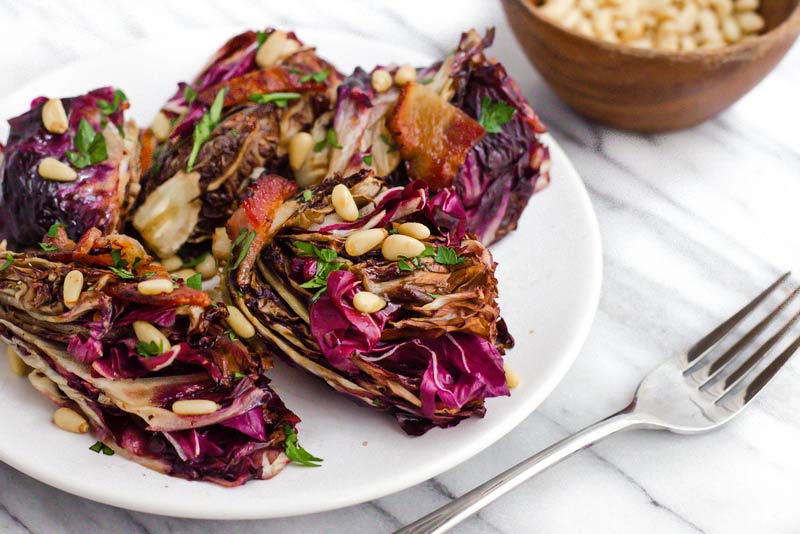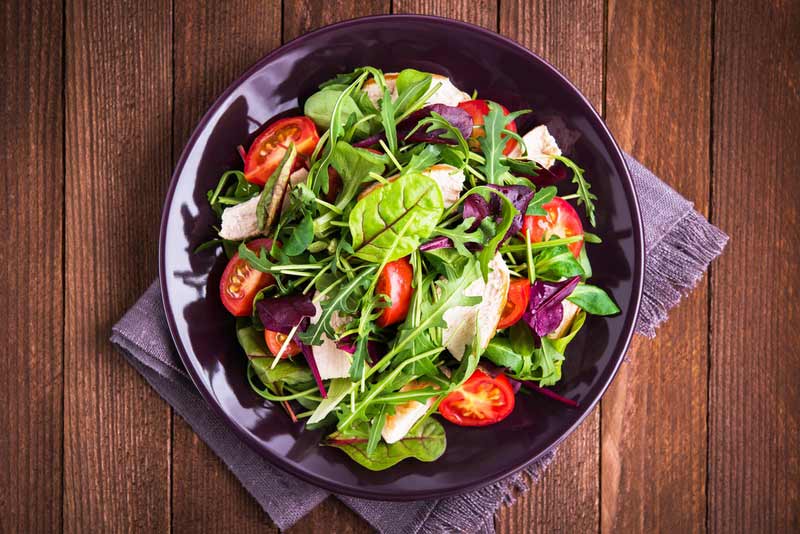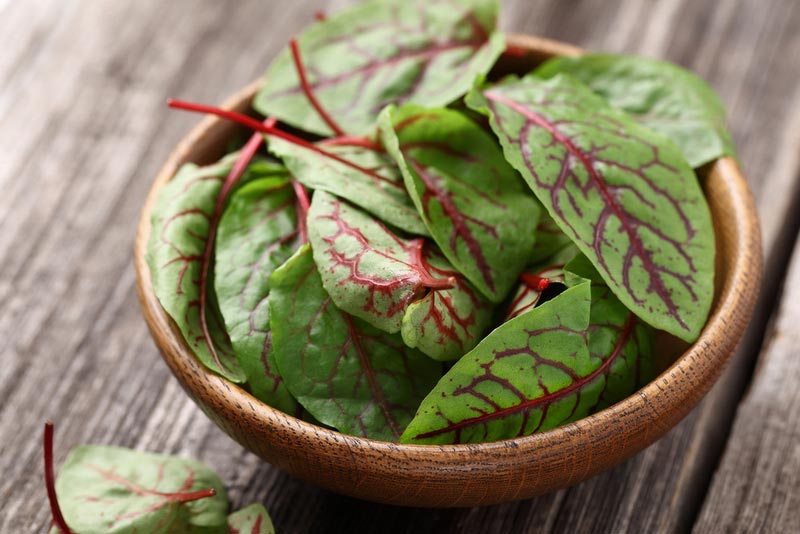The Handy Guide to Salad Greens

Salad greens aren’t just for salad. You’ll be amazed at what you can do with the many varietals of lettuce and greens.
We give you the rundown on common salad greens, including their history, taste, texture, culinary uses, and nutrition, so you’ll never ask yourself “what’s radicchio?” when reading a bag of spring mix again.
Whether you crave crunch and subtle flavor (hello, iceberg lettuce) or soft leaves with a zingy, peppery kick (arugula!) there’s a salad green on this list destined for your plate.
Our handy recipes and cooking recommendations will show you how to mix up your salad routine in the kitchen. You can even try grilling romaine, or roasting radicchio for a milder, earthy flavor than the leaf’s typical spicy kick! Let this guide enlighten you to the world of salad greens and the many ways to incorporate them into your diet.
Iceberg Lettuce
Classic Iceberg exudes Americana: You’ll find its crisp, pale green leaves adding crunch to a burger, or forming an entire foundation in a wedge salad. It’s also great for a quick, homemade salad and tends to be kid-friendly with its neutral flavor and crisp texture.
Iceberg lettuce is notoriously lacking in the nutrition that defines its darker, leafy green counterparts, but it’s nevertheless a great addition to your diet and can help you meet your vitamin and mineral intake goals with vitamins like vitamin C, vitamin K, and vitamin A. (1)
Taste and Texture: Iceberg lettuce has a high water content, giving it a clean, fresh flavor. It definitely is not a bold contender on the flavor scale, but makes for a great foundation to heartier dressings and flavorings. When served fresh, iceberg lettuce is crispy and crunchy, and should break apart with a satisfying snap. It will grow limp and mushy if left alone for too long – so eat it fresh!
How to Use It: A classic “dinner salad” like you’d find in a diner makes great use of iceberg – just add tomatoes, carrots, and a Paleo-friendly ranch or dressing of choice. Like we said before, iceberg lettuce is a great burger and sandwich complement, and in this BLT Avocado stack, it even subs in for bread. Try it in lettuce wraps, too! Pro tip: Iceberg lettuce is one of the most affordable greens you can buy.
Romaine Lettuce
While a recent recall may leave you wary, romaine lettuce is safe to consume now. Sold in heads or hearts, where the outer leaves have been removed, romaine lettuce is a common lettuce used in commercially packaged salads. It’s a key component of Caesar salad, for example.
Unlike many other lettuces, the sturdy leaves on romaine lettuce make it tolerant to heat, meaning it holds up well in grilling or braising.
Taste and Texture: Romaine is bitter in comparison to milder iceberg or butter lettuce. But like iceberg, it’s ultra-crisp and sturdy when served fresh. It actually gets its bitter flavor from a milky liquid excreted when you break the leaves apart.
How to Use It: You can use romaine lettuce in virtually any salad recipe – it’s the usual suspect in Caesar salad, but it’s delicious paired with most fresh veggies. You can try it in this protein-packed turkey cobb salad, shrimp and avocado salad with light cilantro dressing, or as a crunchy complement to this burrito bowl. For a warm alternative, try brushing romaine hearts with olive oil, and throwing a bit of lemon juice, salt, and pepper on it. Grill the leaves until charred, about five minutes.
Radicchio

Technically, radicchio is a chicory leaf, which is closely related to lettuce and often used in salad greens. You’ll notice it as the vibrant red leaves often found in “Italian” salad mixes, or as the head of reddish-purple leaves with white veins on the produce aisle.
Radicchio is loaded with vitamin K, and contains moderate amounts of other essential nutrients. (2) Radicchio is used heavily in Italian cooking. In fact, much of the radicchio consumed around the world is named for the Italian regions it originated from.
Taste and Texture: Radicchio is a strongly flavored leaf vegetable. Served fresh, it can be bitter and spicy. This is why it’s delicious when tossed with milder leaves, as it adds just a hint of flavor. Its crisp leaves hold up well to flavorful vinaigrettes.
When cooked, radicchio mellows some and the bitterness fades. This mellower, warmer version of radicchio complements chicken and fish well.
How to Use It: To add some bite and color to your salads, add freshly chopped radicchio to a mix of greens. For an excellent side dish to any protein, try this roasted balsamic radicchio with bacon and pine nuts. The sharp-flavored leaves mellow into an earthy flavor, and bacon and pine nuts add tons of fatty deliciousness.
Butter Lettuce

Like the name suggests, butter lettuce is buttery soft and has a slightly sweet flavor. The name butter lettuce also includes Bibb and Boston lettuce varieties.
You’ll often find butter lettuce in a clamshell in the grocery store, still attached to a root. It’s a touch more expensive than common varieties like romaine or iceberg, but it’s so silky smooth, it’s worth it. The loosely coiled leaves also make butter lettuce easier to clean – that’s a win in our department.
Taste and Texture: Mild and sweet, butter lettuce is a softer counterpart to crunchy romaine or iceberg. It still holds a little crunch, though.
How to Use It: Butter lettuce leaves are often the perfect size for wrapping up your favorite foods, like in these cashew chicken lettuce tacos or these chicken lettuce wraps with almond butter sauce. Butter lettuce is also gorgeous when served with a simple vinaigrette, no toppings needed!
Arugula
Also known as “rocket”, arugula is known for its zingy, peppery flavor. It’s a salad green with multifaceted uses, from topping a pizza to serving alongside a Mediterranean meal.
Arugula is a great source of vitamin A. (3)
Taste and Texture: Bright, peppery, and a little spicy, arugula is a unique green. Its thin, dark green leaves aren’t particularly crisp, but what they lack in texture they make up in bold flavor.
How to Use It: Adorn your Paleo pizza with a bed of arugula for a bright finish to your meal, or toss arugula with cherry tomatoes and vinaigrette for an acidic and zingy side salad. They’re even a great complement to breakfast, like in this crispy bacon and baked eggs in a Portobello mushroom recipe. Consider tossing them with beet noodles in this beet noodle arugula salad.
Spring Mix (Mesclun)

What is spring mix (also called mesclun)? Basically, it’s all of the above, in baby form! Spring mix is any combination of the baby leaves of a great variety of greens, including arugula, endive, spinach, red leaf lettuce, radicchio, and more. Mesclun technically refers to a French blend of chervil, arugula, leafy lettuce, and endive, but the terms are often used interchangeably.
Taste and Texture: You can expect a wide variety of flavors and textures from spring mix, as it’s a blend of various salad greens. There will be mild basic lettuce leaves, but also zingy, peppery arugula, and spicy radicchio.
How to Use It: Opt for spring mix as a colorful, flavorful base to any salad – it tastes great with heavy, creamy dressings and light vinaigrettes alike. You can also throw some spring mix into a Paleo sandwich for more texture and a healthy dose of greens.
Cress

Technically an herb, cress is a peppery plant that’s closely related to watercress and mustard greens. It’s a nutrient-dense green, with tons of vitamin A, vitamin C, and vitamin K. (4) You’ll find it tossed in salads, adorning soups, and atop sandwiches.
Taste and Texture: Cress has a sharp, spicy flavor packed into its baby leaves. The leaves themselves are soft, but they pack a big punch.
How to Use It: Adorn creamy, rich soups with cress for a peppery kick. Add it to your salads for the same, or pack it in a sandwich for even more flavor.
Beet Greens

Beet greens are exactly what they sound like; they’re the leafy tops of beetroot, and make an excellent addition to any salad. They can also be braised, sautéed, and added to soups for an extra dose of greens.
They’re a nutrient-dense food often tossed out or overlooked, so don’t throw them away the next time you pick up some beets.
Taste and Texture: Delicate beet greens have a sweet, mild flavor, akin to spinach or Swiss chard. They’re soft, but they hold up well in salads and sandwiches.
How to Use It: These greens are great raw, tossed with the beets themselves as well as a light vinaigrette and some walnuts. They can be cooked in the same way as greens like spinach or chard. You can sauté them in avocado oil with some salt, pepper, and lemon, or add them to soups for an extra dose of greens.

(You’ll Also Love: How to Start Eating Vegetables – When You Don’t Like Them)
The post The Handy Guide to Salad Greens appeared first on PaleoPlan.
from PaleoPlan http://bit.ly/2GloGka
Entry Published : February 09, 2019 at 11:31AM
EntryContent :

Salad greens aren’t just for salad. You’ll be amazed at what you can do with the many varietals of lettuce and greens.
We give you the rundown on common salad greens, including their history, taste, texture, culinary uses, and nutrition, so you’ll never ask yourself “what’s radicchio?” when reading a bag of spring mix again.
Whether you crave crunch and subtle flavor (hello, iceberg lettuce) or soft leaves with a zingy, peppery kick (arugula!) there’s a salad green on this list destined for your plate.
Our handy recipes and cooking recommendations will show you how to mix up your salad routine in the kitchen. You can even try grilling romaine, or roasting radicchio for a milder, earthy flavor than the leaf’s typical spicy kick! Let this guide enlighten you to the world of salad greens and the many ways to incorporate them into your diet.
Iceberg Lettuce
Classic Iceberg exudes Americana: You’ll find its crisp, pale green leaves adding crunch to a burger, or forming an entire foundation in a wedge salad. It’s also great for a quick, homemade salad and tends to be kid-friendly with its neutral flavor and crisp texture.
Iceberg lettuce is notoriously lacking in the nutrition that defines its darker, leafy green counterparts, but it’s nevertheless a great addition to your diet and can help you meet your vitamin and mineral intake goals with vitamins like vitamin C, vitamin K, and vitamin A. (1)
Taste and Texture: Iceberg lettuce has a high water content, giving it a clean, fresh flavor. It definitely is not a bold contender on the flavor scale, but makes for a great foundation to heartier dressings and flavorings. When served fresh, iceberg lettuce is crispy and crunchy, and should break apart with a satisfying snap. It will grow limp and mushy if left alone for too long – so eat it fresh!
How to Use It: A classic “dinner salad” like you’d find in a diner makes great use of iceberg – just add tomatoes, carrots, and a Paleo-friendly ranch or dressing of choice. Like we said before, iceberg lettuce is a great burger and sandwich complement, and in this BLT Avocado stack, it even subs in for bread. Try it in lettuce wraps, too! Pro tip: Iceberg lettuce is one of the most affordable greens you can buy.
Romaine Lettuce
While a recent recall may leave you wary, romaine lettuce is safe to consume now. Sold in heads or hearts, where the outer leaves have been removed, romaine lettuce is a common lettuce used in commercially packaged salads. It’s a key component of Caesar salad, for example.
Unlike many other lettuces, the sturdy leaves on romaine lettuce make it tolerant to heat, meaning it holds up well in grilling or braising.
Taste and Texture: Romaine is bitter in comparison to milder iceberg or butter lettuce. But like iceberg, it’s ultra-crisp and sturdy when served fresh. It actually gets its bitter flavor from a milky liquid excreted when you break the leaves apart.
How to Use It: You can use romaine lettuce in virtually any salad recipe – it’s the usual suspect in Caesar salad, but it’s delicious paired with most fresh veggies. You can try it in this protein-packed turkey cobb salad, shrimp and avocado salad with light cilantro dressing, or as a crunchy complement to this burrito bowl. For a warm alternative, try brushing romaine hearts with olive oil, and throwing a bit of lemon juice, salt, and pepper on it. Grill the leaves until charred, about five minutes.
Radicchio

Technically, radicchio is a chicory leaf, which is closely related to lettuce and often used in salad greens. You’ll notice it as the vibrant red leaves often found in “Italian” salad mixes, or as the head of reddish-purple leaves with white veins on the produce aisle.
Radicchio is loaded with vitamin K, and contains moderate amounts of other essential nutrients. (2) Radicchio is used heavily in Italian cooking. In fact, much of the radicchio consumed around the world is named for the Italian regions it originated from.
Taste and Texture: Radicchio is a strongly flavored leaf vegetable. Served fresh, it can be bitter and spicy. This is why it’s delicious when tossed with milder leaves, as it adds just a hint of flavor. Its crisp leaves hold up well to flavorful vinaigrettes.
When cooked, radicchio mellows some and the bitterness fades. This mellower, warmer version of radicchio complements chicken and fish well.
How to Use It: To add some bite and color to your salads, add freshly chopped radicchio to a mix of greens. For an excellent side dish to any protein, try this roasted balsamic radicchio with bacon and pine nuts. The sharp-flavored leaves mellow into an earthy flavor, and bacon and pine nuts add tons of fatty deliciousness.
Butter Lettuce

Like the name suggests, butter lettuce is buttery soft and has a slightly sweet flavor. The name butter lettuce also includes Bibb and Boston lettuce varieties.
You’ll often find butter lettuce in a clamshell in the grocery store, still attached to a root. It’s a touch more expensive than common varieties like romaine or iceberg, but it’s so silky smooth, it’s worth it. The loosely coiled leaves also make butter lettuce easier to clean – that’s a win in our department.
Taste and Texture: Mild and sweet, butter lettuce is a softer counterpart to crunchy romaine or iceberg. It still holds a little crunch, though.
How to Use It: Butter lettuce leaves are often the perfect size for wrapping up your favorite foods, like in these cashew chicken lettuce tacos or these chicken lettuce wraps with almond butter sauce. Butter lettuce is also gorgeous when served with a simple vinaigrette, no toppings needed!
Arugula
Also known as “rocket”, arugula is known for its zingy, peppery flavor. It’s a salad green with multifaceted uses, from topping a pizza to serving alongside a Mediterranean meal.
Arugula is a great source of vitamin A. (3)
Taste and Texture: Bright, peppery, and a little spicy, arugula is a unique green. Its thin, dark green leaves aren’t particularly crisp, but what they lack in texture they make up in bold flavor.
How to Use It: Adorn your Paleo pizza with a bed of arugula for a bright finish to your meal, or toss arugula with cherry tomatoes and vinaigrette for an acidic and zingy side salad. They’re even a great complement to breakfast, like in this crispy bacon and baked eggs in a Portobello mushroom recipe. Consider tossing them with beet noodles in this beet noodle arugula salad.
Spring Mix (Mesclun)

What is spring mix (also called mesclun)? Basically, it’s all of the above, in baby form! Spring mix is any combination of the baby leaves of a great variety of greens, including arugula, endive, spinach, red leaf lettuce, radicchio, and more. Mesclun technically refers to a French blend of chervil, arugula, leafy lettuce, and endive, but the terms are often used interchangeably.
Taste and Texture: You can expect a wide variety of flavors and textures from spring mix, as it’s a blend of various salad greens. There will be mild basic lettuce leaves, but also zingy, peppery arugula, and spicy radicchio.
How to Use It: Opt for spring mix as a colorful, flavorful base to any salad – it tastes great with heavy, creamy dressings and light vinaigrettes alike. You can also throw some spring mix into a Paleo sandwich for more texture and a healthy dose of greens.
Cress

Technically an herb, cress is a peppery plant that’s closely related to watercress and mustard greens. It’s a nutrient-dense green, with tons of vitamin A, vitamin C, and vitamin K. (4) You’ll find it tossed in salads, adorning soups, and atop sandwiches.
Taste and Texture: Cress has a sharp, spicy flavor packed into its baby leaves. The leaves themselves are soft, but they pack a big punch.
How to Use It: Adorn creamy, rich soups with cress for a peppery kick. Add it to your salads for the same, or pack it in a sandwich for even more flavor.
Beet Greens

Beet greens are exactly what they sound like; they’re the leafy tops of beetroot, and make an excellent addition to any salad. They can also be braised, sautéed, and added to soups for an extra dose of greens.
They’re a nutrient-dense food often tossed out or overlooked, so don’t throw them away the next time you pick up some beets.
Taste and Texture: Delicate beet greens have a sweet, mild flavor, akin to spinach or Swiss chard. They’re soft, but they hold up well in salads and sandwiches.
How to Use It: These greens are great raw, tossed with the beets themselves as well as a light vinaigrette and some walnuts. They can be cooked in the same way as greens like spinach or chard. You can sauté them in avocado oil with some salt, pepper, and lemon, or add them to soups for an extra dose of greens.

(You’ll Also Love: How to Start Eating Vegetables – When You Don’t Like Them)
The post The Handy Guide to Salad Greens appeared first on PaleoPlan.
via IFTTT
No comments: